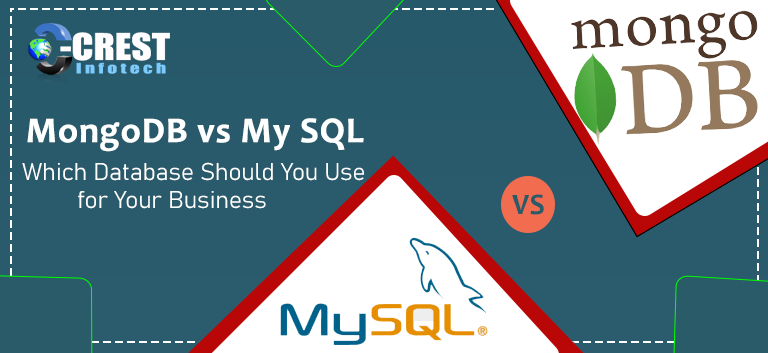Choosing a database for modern apps has proven to be a difficult task for many. Particularly because relational DBMSs such as PostgreSQL, MS SQL, and MySQL have become popular in recent years.As a result, MySQL has always been a preferred option for many businesses in need of a relational database. However, with growing variety and large volumes of data, the non-relational databases like MongoDB have emerged as a solution for many enterprises’ need for fluid data.
The introduction of the latest non-relational database has sparked a fight between MongoDB and MySQL. Entrepreneurs are finding it difficult to choose between the two due to the rivalry. But don’t worry, because in this blog, we’ll compare both databases based on a number of factors to help you decide which one is better.
We’ll even tell you when to use MongoDB and when to use MySQL.So, without further ado, let’s get this party started.MySQL is a relational database management system that is open-source and currently operated by Oracle. MySQL AB, on the other hand, designed it.
MySQL is a seasoned IT veteran, having been around since 1995. MySQL, like other relational DBMSs, uses SQL (structural query language) to access the database and store data in tables.The migration procedure is required for any changes to the schema that may have a major impact on the application’s output. It can also switch the database to offline mode.
Let’s see some of the big names that use MySQL
- US Navy
- Walmart
- NASA
- YouTube
- Netflix
- Spotify
- Paypal
MongoDB, created by MongoDB Inc., is a well-known non-relational database. While the concept was conceived in 2007, the first version was released in 2010. In this sort of DBMS, the data is stored in the form known as BSON.
The MongoDB query language is generally used to store related data for query access. The fields are different for each document in this case, and you won’t need to tell the systems about the document structure.It allows you to build and add a new field to a document without having to make any changes to other documents in the array.
You don’t need to put MongoDB into offline mode because the central device catalogue doesn’t need to be updated. Furthermore, you can optionally use schema validation to apply data governance across all collections.In application mode, MongoDB’s document data model naturally maps the objects.
As a result, developers find MongoDB to be easier to learn and use. By representing hierarchical associations, users can store arrays without any hassle.Furthermore, this NoSQL solution includes on-board replication and auto-sharding embedding, which improves availability and scalability.
MongoDB is used by many successful organizations such as:
- T-Mobile
- Klout
- SurveyMonkey
- Citrix
- Sony
- Foursquare
- Zendesk
- MuleSoft
- InVision
- Hootsuite
In application mode, MongoDB’s document data model naturally maps the objects. As a result, developers find MongoDB to be easier to learn and use. By representing hierarchical associations, users can store arrays without any hassle.Furthermore, this NoSQL solution includes on-board replication and auto-sharding embedding, which improves availability and scalability.
MongoDB vs MySQL: Database Structure
Let’s take a look at the database structures of MongoDB and MySQL. The data value is stored in tables by the MySQL database structure, which can be accessed using SQL. The database structure is described by the schema. The schema’s most important condition is that the rows in the table have the same structure. It also necessitates the use of unique data types to represent its values.
The data is stored in JSON-like documents in the MongoDB database, which come in a variety of structures. It stores the relevant data sets together to improve query speed. The MongoDB query language is then used to access these sets.Since the database is schema-free, mobile app developers don’t have to specify any document structures when creating documents.
MongoDB vs MySQL: Index Optimization
For the purpose of searching data, both MySQL and MongoDB use indexes. Where an index is not established or found, the difference is in the method.In the case of MySQL index optimization, if the index isn’t specified, the database engines will search the entire table for specific rows.When the index isn’t found in MongoDB, each document in the set is scanned for a match to the question argument, and the document with the best match is chosen.
MongoDB vs MySQL: Database Deployment
MongoDB’s databases are written in C, C++, and JavaScript. Solaris, OS X, Windows, and Linux binaries are available.MySQL is written in C and C++ and includes binaries for Windows, AIX, FreeBSD, HP-US, NetBSD, OS X, Linux, BSDi, IRIX, and other operating systems.
MongoDB vs MySQL: Replication
MySQL databases allow both master-slave and master-master replication. You can replicate several masters in parallel with this multi-source replication.MongoDB, on the other hand, has auto-elections, built-in replication, and sharding capabilities. Developers may use auto-elections to build a backup database that will take over when the primary database fails.
MongoDB vs MySQL: Speed and Performance
When compared to MySQL, MongoDB is known for being better at managing large quantities of unregulated data. It’s because the entity data is stored in a single folder. Furthermore, it enables users to question workload in a responsive manner. It also enables the user to read and write data from a single location.
When dealing with large amounts of data, MySQL is significantly slower than MongoDB. MySQL has a hard time dealing with large amounts of unstructured data. It’s because the data is dispersed through several tables, all of which must be accessed in order to write and read the data.



